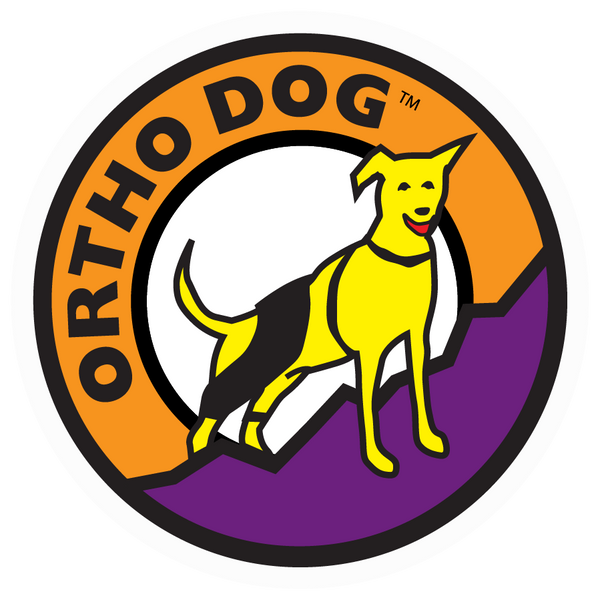Australian shepherds, commonly called Aussies, are known for their high levels of intelligence, loyal and affectionate dispositions, and extremely energetic natures. Aussies are happy to run, hike, and play for hours with their humans.

This active breed’s fun-loving personality makes it all the more striking when they start to display signs of pain or discomfort in their hips and hind legs. Below are some common problems that can cause limping and leg, knee or hip pain in your pup.
Canine Hip Dysplasia
Canine hip dysplasia (CHD) is one of the most common canine ailments. Often it affects larger breeds but it is also commonly diagnosed in Australian Shepherds. Using a canine hip brace can help releive the discomfort of CHD and help improve mobility.
Causes of Hip Dysplasia in Australian Shepherds
In a healthy dog’s hips, the ball (top of the femur) and socket (part of the pelvis) fit together, allowing for smooth motion of the hip joint. CHD is a malformation of that joint which causes the ball and socket not to fit together comfortably, resulting in the joint pieces rubbing or grinding together. This is a painful condition that can cause lameness, limping, or degeneration of the joint in extreme cases.
Dog hip dysplasia is a genetic condition, so puppies born to dogs who have shown symptoms are more likely to develop them over time. There are also some environmental conditions that can exacerbate the condition, including obesity. Symptom prevention and early treatment starts with a healthy diet and exercise routine.
Australian Shepherd Hip Dysplasia Symptoms
Depending on the severity of the condition, dog hip dysplasia can manifest in many different ways. Some dogs show serious symptoms from an early age (early-onset CHD can affect puppies as young as four months), while others may show little or no signs of discomfort throughout their lives. Some of the most common symptoms include lameness, trouble standing up, limping, a “bunny hop” gait, reluctance to jump up or climb stairs, and a dislike of having the hip area touched or manipulated. In severe cases, loss of muscle mass may occur in affected areas. Symptoms primarily affect the hip area and hind legs.

CHD Diagnosis & Treatment for Your Aussie
The only way to be sure your pet has CHD is by consulting with a veterinarian. A physical exam and X-rays of the hips and pelvis can confirm the diagnosis, and your vet may recommend one of several treatment options depending on how severe the case is.
According to the Orthopedic Foundation for Animals, “Studies have shown that up to 76% of severely dysplastic dogs with arthritis secondary to Hip Dysplasia are able to function and live comfortable, quality lives with conservative management.”
Suggested conservative treatments may include physical therapy, canine chiropractic, acupuncture, anti-inflammatories, massage therapy, or diet and lifestyle changes. In the most extreme cases, your vet might recommend hip surgery for the best long-term results. Due to a number of factors, invasive surgery may not necessary or appropriate for your dog.
When surgery is not the best option, consider a dog hip brace to improve your furry friend’s quality of life. Ortho Dog’s Hip Hound Brace is designed to provide support to the hips and hind legs, which reduces pressure on the joint to provide pain relief and mobility assistance.
Ortho Dog’s orthopedic brace for dogs stabilizes the hip and lower back areas by holding the head of the femur in the hip socket. A brace can also be helpful as a follow-up to surgery to aid in your Aussie's healing process.
Torn ACL / CCL
Sometimes running at top speeds or pivoting on a dime to catch a ball can lead to a torn cranial cruciate ligament (CCL), the canine equivalent of a human ACL. The CCL is a thin connective tissue in the middle of a dog’s knee that connects the femur (bone above the knee) to the tibia (bone below the knee). The CCL is always load-bearing, which can make the ligament susceptible to injury. Most partial tears become complete tears due to continued physical activities.
Your Dog’s Torn CCL Treatment
After a licensed veterinarian diagnoses your dog with a CCL tear, they may decide that surgery is the best option. Many dogs, however, are able to recover from an ACL tear with conservative treatment rather than invasive surgery. We recently covered it on the blog.
When it comes to non-invasive ACL/CCL treatment options, your pitbull may find relief through acupuncture, massage therapy, supplements, red light and/or cold laser therapy, canine chiropractic, and water therapy. The success of any treatment option depends on the age, health, and activity level of the dog. Ortho Dog’s cruciate care knee brace for torn ACLs and other injuries can stabilize the knee to reduce pain and inflammation during healing.

In 60% of cases, a dog with a torn ACL will later injure the other knee. By stabilizing the injured knee with a dog knee brace (as well as balancing the back and hip areas), further injury may be avoided.
Other Causes of Canine Leg or Hip Pain
Panosteitis: sometimes referred to as “growing pains” this condition is temporary.
Hypertrophic osteodystrophy (or HOD): another growth-related leg issue that causes inflammation of the long bones.
Osteoarthritis: a common ailment in older dogs caused by age-related muscle and joint degeneration.
Always consult with a veterinary professional for the correct diagnosis before moving forward with any treatment plan for your beloved pet.
It is never fun to watch your dog struggle with hip or leg pain, and it can be especially frustrating to watch pain limit your Australian shepherd’s natural love of running and playing. However, there are many treatment options that can ensure your Aussie is able to live a long, pain-free life.




